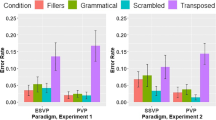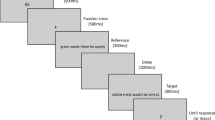Abstract
When asked to decide if an ungrammatical sequence of words is grammatically correct or not, readers find it more difficult to do so (longer response times (RTs) and more errors) if the ungrammatical sequence is created by transposing two words from a correct sentence (e.g., the white was cat big) compared with matched ungrammatical sequences where transposing two words does not produce a correct sentence (e.g., the white was cat slowly). Here, we provide a further exploration of transposed-word effects when reading unspaced text in Experiment 1, and when reading from right-to-left (“backwards” reading) in Experiment 2. We found significant transposed-word effects in error rates but not in RTs, a pattern previously found in studies using a one-word-at-a-time sequential presentation. We conclude that the absence of transposed-word effects in RTs in the present study and prior work is due to that atypical nature of the way that text was presented. Under the hypothesis that transposed-word effects at least partly reflect a certain amount of parallel word processing during reading, we further suggest that the ability to process words in parallel would require years of exposure to text in its regular format.



Similar content being viewed by others
Notes
We also performed a power analysis based on the on-line study of Mirault et al. (2018) with random items and participants (Green & MacLeod, 2016). Specifically, 200 Monte Carlo simulations were performed using the SimR package in RStudio. Results showed that with 40 participants (which in this design equates to 1,600 observations per condition, as recommended by Brysbaert & Stevens, 2018), power was 89.5% to observe the main effect. Therefore, having at least 40 participants per experiment was deemed sufficient.
References
Baayen, R. H., Davidson, D. J., & Bates, D. M. (2008). Mixed-effects modeling with crossed random effects for subjects and items. Journal of Memory and Language, 59(4), 390–412. https://doi.org/10.1016/j.jml.2007.12.005
Brysbaert, M., & Stevens, M. (2018). Power Analysis and Effect Size in Mixed Effects Models: A Tutorial. Journal of Cognition, 1(1), 9. https://doi.org/10.5334/joc.10
Bürkner, P.-C. (2017). brms: An R package for Bayesian multilevel models using Stan. Journal of Statistical Software, 80(1), 1–28. https://doi.org/10.18637/jss.v080.i01
Cousineau, D. (2005). Confidence intervals in within-subject designs: A simpler solution to Loftus and Masson’s method. Tutorials in Quantitative Methods for Psychology, 1(1), 42–45. https://doi.org/10.20982/tqmp.01.1.p042
Dufour, S., Mirault, J., & Grainger, J. (2022). Transposed-word effects in speeded grammatical decisions to sequences of spoken words. Scientific Reports, 12(1), 22035. https://doi.org/10.1038/s41598-022-26584-2
Gibson, E., Bergen, L., & Piantadosi, S. T. (2013). Rational integration of noisy evidence and prior semantic expectations in sentence interpretation. Proceedings of the National Academy of Sciences, 110(20), 8051–8056. https://doi.org/10.1073/pnas.1216438110
Green, P., & MacLeod, C. J. (2016). SIMR: an R package for power analysis of generalized linear mixed models by simulation. Methods in Ecology and Evolution, 7(4), 493–498. https://doi.org/10.1111/2041-210X.12504
Huang, K. J., & Staub, A. (2021). Using eye tracking to investigate failure to notice word transpositions in reading. Cognition, 216, 104846.
Huang, K., & Staub, A. (2023). The transposed-word effect does not require parallel word processing: Failure to notice transpositions with serial presentation of words. Psychonomic Bulletin & Review, 30(1), 393–400. https://doi.org/10.3758/s13423-022-02150-9
Liu, Z., Li, Y., Paterson, K. B., & Wang, J. (2020). A transposed-word effect in Chinese reading. Attention, Perception, & Psychophysics, 82(8), 3788–3794. https://doi.org/10.3758/s13414-020-02114-y
Liu, Z., Li, Y., Cutter, M. G., Paterson, K. B., & Wang, J. (2022). A transposed-word effect across space and time: Evidence from Chinese. Cognition, 218, 104922. https://doi.org/10.1016/j.cognition.2021.104922
Milledge, S. V., Bhatia, N., Mensah-Macleod, L., Raghvani, P., McGowan, V. A., Elsherif, M. M., Cutter, M. G., Wang, J., Liu, Z., & Paterson, K. (2023). The Transposed-Word Effect Provides No Evidence for Parallel Processing. Manuscript Submitted for Publication.
Mirault, J., Snell, J., & Grainger, J. (2018). You That Read Wrong Again! A Transposed-Word Effect in Grammaticality Judgments. Psychological Science, 29(12), 1922–1929. https://doi.org/10.1177/0956797618806296
Mirault, J., Leflaëc, C., & Grainger, J. (2022a). Orthographic relatedness and transposed-word effects in the grammatical decision task. Attention, Perception, & Psychophysics, 84(3), 1043–1051. https://doi.org/10.3758/s13414-021-02421-y
Mirault, J., Vandendaele, A., Pegado, F., & Grainger, J. (2022b). Transposed-word effects when reading serially. PLOS ONE, 17(11), e0277116. https://doi.org/10.1371/journal.pone.0277116
Mollica, F., Siegelman, M., Diachek, E., Piantadosi, S. T., Mineroff, Z., Futrell, R., Kean, H., Qian, P., & Fedorenko, E. (2020). Composition is the Core Driver of the Language-selective Network. Neurobiology of Language, 1(1), 104–134. https://doi.org/10.1162/nol_a_00005
Pegado, F., & Grainger, J. (2020). A transposed-word effect in same-different judgments to sequences of words. Journal of Experimental Psychology: Learning, Memory, and Cognition, 46, 1364–1371.
Pegado, F., & Grainger, J. (2021). On the noisy spatiotopic encoding of word positions during reading: Evidence from the change-detection task. Psychonomic Bulletin & Review, 28(1), 189–196. https://doi.org/10.3758/s13423-020-01819-3
R Core Team, R. (2022). R: A language and environment for statistical computing.
Snell, J., & Grainger, J. (2019). Word position coding in reading is noisy. Psychonomic Bulletin & Review, 26(2), 609–615. https://doi.org/10.3758/s13423-019-01574-0
Snell, J., & Grainger, J. (2019). Readers Are Parallel Processors. Trends in Cognitive Sciences, 23(7), 537–546. https://doi.org/10.1016/j.tics.2019.04.006
Snell, J., Meeter, M., & Grainger, J. (2017). Evidence for simultaneous syntactic processing of multiple words during reading. PLoS ONE, 12, e0173720.
Wen, Y., Mirault, J., & Grainger, J. (2021). Fast syntax in the brain: Electrophysiological evidence from the rapid parallel visual presentation paradigm (RPVP). Journal of Experimental Psychology: Learning, Memory, and Cognition, 47(1), 99–112. https://doi.org/10.1037/xlm0000811
Wen, Y., Mirault, J., & Grainger, J. (2022). A transposed-word effect on word-in-sequence identification. Psychonomic Bulletin & Review, 29(6), 2284–2292. https://doi.org/10.3758/s13423-022-02132-x
Acknowledgements
We would like to thank Arnaud Giraud-Guigues for his assistance in running the pilot work for this study.
Funding
This research was supported by the European Research Council (ERC grant 742141) awarded to JG and the Flanders research foundation (FWO grant 1154021n) awarded to AV. Pôle pilôte Ampiric, Institut National Supérieur du Professorat et de l’Éducation, Aix-Marseille Université to FP and JM.
Author information
Authors and Affiliations
Contributions
JM: programming, data analysis, and writing
AV: programming, data analysis, and data presentation
FP: design
JG: design, supervision, and writing
Corresponding author
Ethics declarations
Conflict of interest
The authors declare no conflict of interest.
Preregistration and Open-data
The study was not pre-registered. Materials, data, and analyses can be found via the Open Science Framework at following link: https://osf.io/z5erp/.
Ethics statement
All experiments were performed in accordance with the provisions of the World Medical Association Declaration of Helsinki and ethics approval was obtained from the Comité de Protection des Personnes SUD-EST IV (No. 17/051).
Additional information
Publisher's note
Springer Nature remains neutral with regard to jurisdictional claims in published maps and institutional affiliations.
Rights and permissions
Springer Nature or its licensor (e.g. a society or other partner) holds exclusive rights to this article under a publishing agreement with the author(s) or other rightsholder(s); author self-archiving of the accepted manuscript version of this article is solely governed by the terms of such publishing agreement and applicable law.
About this article
Cite this article
Mirault, J., Vandendaele, A., Pegado, F. et al. The impact of atypical text presentation on transposed-word effects. Atten Percept Psychophys 85, 2859–2868 (2023). https://doi.org/10.3758/s13414-023-02760-y
Accepted:
Published:
Issue Date:
DOI: https://doi.org/10.3758/s13414-023-02760-y




